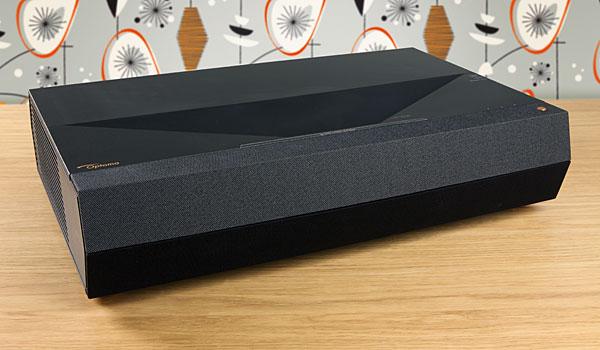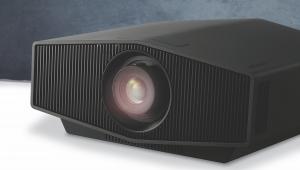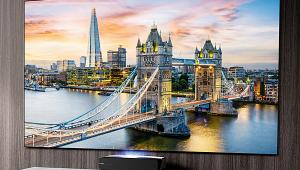Optoma UHZ65UST ultra-short-throw 4K projector review

 Optoma's 4K ultra-short-throw PJ is a convincing TV replacement, suggests Steve May.
Optoma's 4K ultra-short-throw PJ is a convincing TV replacement, suggests Steve May.
Able to cast a big image in a relatively small room, positioned just centimetres from a white wall, it's not difficult to see the appeal of an ultra-short-throw (UST) projector. There's no fear of walking in front of the beam either, causing oversized shadows on the action. The downside is that almost all UST projectors look like escapees from the office Christmas party.
The Optoma UHZ65UST is very different. Here's a compact beamer that even non-techies might covet. With its brass feet and fabric frontage, it's a remarkably handsome beast.
As tends to be the norm with these things, there's a sound system built-in. But, again, here there's real consumer sensibility about its design. Wearing the NuForce branding of Optoma's audio division, this PJ's sound engine is styled like a conventional soundbar. Placed on an AV shelf in front of you, it looks quite neat.
The UHZ65UST has a wide range of connective options too. On it's right-hand side are USB and HDMI inputs for easy hook up, while to the rear are two additional HDMI v2.0 ports, one of which is ARC enabled. There's also an optical digital audio output and 3.5mm minijack. For network services, the PJ features both Wi-Fi and Ethernet.
The UHZ65UST packs a single-chip UHD DLP device, which uses mirror flipping to deliver a 2160p pixel dense image, coupled to a bright laser light source. The latter gives the unit TV-like functionality. Switch on and you get an image; there's no lamp warm up required.
The projector is HDR compatible, recognising HLG and HDR10 content streams. Of course, such compatibility is no guarantee of an HDR-like viewing experience as seen on a flatscreen. Our best hope is always that the projector doesn't dull down excessively in order to favour highlights. As it happens, the UHZ65UST makes a valiant attempt at managing HDR content, retaining a bright average picture level without crushing blacks.
The UHZ65UST may wear a UHD badge, but it's worth reiterating that no single-chip DLP model is natively 4K. Texas Instruments' DMD solution is a variation on the pixel-shifting theme as embraced by Epson and previously JVC, albeit different in mechanics and given the 4K seal of approval by the Consumer Technology Association.
 So just how close is its performance to native 2160p? With 4K resolution test patterns, the UHZ65UST is unsurprisingly unable to discern ultra-fine UHD detail. However, with real-world content, images certainly look crisp, often displaying greater subjective sharpness than comparable 1080p sources.
So just how close is its performance to native 2160p? With 4K resolution test patterns, the UHZ65UST is unsurprisingly unable to discern ultra-fine UHD detail. However, with real-world content, images certainly look crisp, often displaying greater subjective sharpness than comparable 1080p sources.
Throwing Shapes
It's not just the premium styling which sets this UST model apart from rivals. It also boasts some advanced functionality, including geometric correction, something that appears to have trickled down from Optoma's professional AV projection lineup. This allows you to warp an image if you have something other than a flat surface to project onto. I suspect many will find the feature useful – not everyone has the luxury of a perfectly flat wall to double as a screen. For non-cinephile viewing, perhaps at a kid's birthday party, it can actually make the most difficult of rooms bigscreen friendly.
Another welcome user innovation is automatic dimming. A sensor placed near the light path automatically dims down the projector's light output, to protect the peepers of the inquisitive. This will be welcome in households where small children might be tempted to take a closer look.
Another nicety includes support for the DLP-link system for 3D projection, although no 3D glasses are included in the package.
If you're not using geometric correction, setup is relatively straightforward. Just unbox and shuffle into position to get the required image size from its 0.25:1 throw ratio. A test pattern is available to fine-tune positioning. Typically, you need less than a metre from the wall to throw a 100in image.
While most owners will settle for displaying on a white wall, the projector might also be partnered with a fixed ALR (Ambient Light Rejecting) screen, which will significantly improve brightness and contrast. Optoma sells the 100in ALR101 (£1,200) just for the job.
 |
Home Cinema Choice #351 is on sale now, featuring: Samsung S95D flagship OLED TV; Ascendo loudspeakers; Pioneer VSA-LX805 AV receiver; UST projector roundup; 2024’s summer movies; Conan 4K; and more
|























































